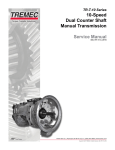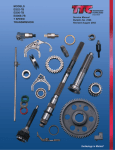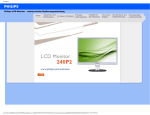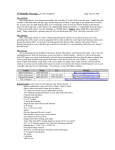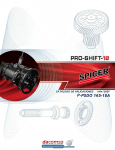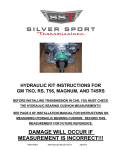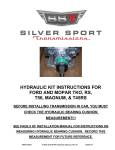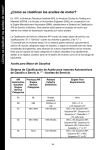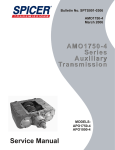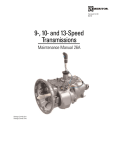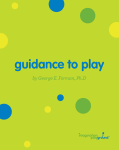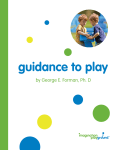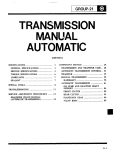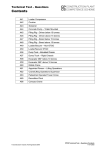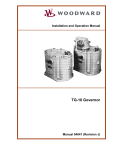Download SERVICE MANUAL.v3
Transcript
Bulletin No. SPSDO165-18 April 2004 18 Speed TRANSMISSION Service Manual MODELS: PSDO165–18 PSDO185–18 PSDO205–18 PRO-SHIFT-18-Speed Transmission TABLE OF CONTENTS Section I General Information Specifications .................................................................................................................................................... 3 Torque Specifications ........................................................................................................................................ 4 Driver Instructions ............................................................................................................................................. 5 Section II Maintenance Air Line Piping Diagram ........................................................................................................................................... 7 Filter Regulator ....................................................................................................................................................... 8 Lubrication ............................................................................................................................................................... 9 Section III General Disassembly ................................................................................................. 10 Section IV Shift Lever Disassembly ............................................................................................ 12 Section V Electrical Harness ....................................................................................................... 13 Section VI Range Case Disassembly Case Exploded Drawing ........................................................................................................................................ 14 Gears Exploded Drawing ....................................................................................................................................... 15 Disassembly .......................................................................................................................................................... 17 Section VII Main Case Disassembly Main Case Exploded Drawing ............................................................................................................................... 22 Clutch Housing Exploded Drawing ........................................................................................................................ 23 Main Case Gears Exploded Drawing ..................................................................................................................... 24 Disassembly .......................................................................................................................................................... 27 Section VIII Countershaft Disassembly & Reassembly............................................................. 31 Section IX Cleaning & Inspection Procedures ............................................................................................................. 32 Section X Main Case Reassembly ............................................................................................................................... 33 Section XI Range Case Reassembly ........................................................................................................................... 37 Section XII Shift Lever Reassembly ............................................................................................................................. 41 Section XIII Troubleshooting ........................................................................................................................................ 42 2 SAFETY FIRST Carefully read this service manual before beginning any work on your Spicer transmission. General Safety Precautions Throughout this literature, you will see symbols that warn of potential physical danger or product damage if the accompanying instructions aren’t followed. Here are the symbols and their meanings. S ! 9 ! This symbol indicates a potentially hazardous situation. If the instructions aren’t followed, the result could be death or serious injury. ! S Use a hoist whenever lifting the transmission or shaft assemblies. Using a hoist can help prevent muscle strain or other possible injuries. ! S Always wear safety glasses when working on the transmissions to help prevent possible eye injury due to small parts (such as snap rings) or metal chips that may fly up unexpectedly during a tear down or rebuild. ! S ; This symbol indicates that you must do something in order for the transmission to function properly. For example, you must use only one gasket underneath the shift tower. If it is eliminated, or more than one gasket is used, binding can occur. This would prevent proper shifting of the transmission and could damage the unit. ! S Be careful when picking up gears or other sharp components. If you aren’t careful, you could cut your hands. Consider wearing heavy cloth gloves or covering sharp objects with shop towels before picking them up. When draining the transmission prior to working on it, be careful to let the unit cool down first. Otherwise, hot transmission fluid could cause burns. This symbol indicates that you must NOT do something in order to avoid damaging the transmission. For example, you must not use sealant underneath the shift tower. Using sealant underneath the tower will prevent proper interlock functioning and could damage the unit. Be sure you understand all procedures and instructions in this manual before you begin working on your Spicer Transmission. If you have any questions, contact your Spicer Transmission representative. The information in this service manual was current at the time of publication. This information is subject to change at any time without notice. 3 GENERAL INFORMATION SECTION I PS D O 205 - 18 A PRO SHIFT RATIO GROUP NUMBER OF GEARS DOUBLE OVERDRIVE PSDO1065-18A TORQUE CAPACITY PSDO1085-18A GEAR RATIOS Gear Ratio 1 2nd 3rd 4th 5th 6th 7th 8th 9th 10th 11th 12th 13th 14th 15th 16th 17th 18th Rev. 1 Rev. 2 Rev. 3 Rev. 4 14.89 12.41 10.40 8.66 7.32 6.09 5.05 4.21 3.54 2.95 2.47 2.06 1.74 1.45 1.20 1.00 0.84 0.70 15.64 13.03 3.72 3.10 st PSDO205-18A SPECIFICATIONS %Step 20% 19% 20% 18% 20% 21% 20% 19% 20% 19% 20% 18% 20% 21% 20% 19% 20% Ratio Coverage 21.3:1 Length 95 cm Weight 365 kg Input Shaft 50.8 mm x 10 Spline End Yoke SPL-250, 1810, 1710 Clutch Housing SAE #1 Clutch Spicer 15.5” Oil Capacity 13.9 litres Speedometer Electronic PTO Openings 8 bolt left & 6 bolt rightside PTO Drive Gears Both sides, 52 teeth 6 pitch gear. Both gears turn at .57 or .70 of engine speed. SHIFT PATTERN R1 R2 R3 R4 1 4 2 3 4 11 12 7 8 15 16 5 6 13 14 9 10 17 18 GENERAL INFORMATION SECTION I TORQUE SPECIFICATIONS FOR NUTS AND CAP SCREWS Part Name Cap Screw or Nut Nominal Thread Size (Dia.) Inches mm .250 6 .312 .375 10 .438 Wrench Torque (ft. lbs) Non Locking Type Locking Type (Bonded Nylon Patch) Min Max Min Max 7 10 10 13 13 17 20 24 25 32 34 41 40 50 52 62 60 80 78 98 80 100 12 .500 60 80 14 Nut .562 90 115 112 137 .625 120 150 150 180 .750 200 250 240 290 1.250 400 450 1.375 550 600 1.750 550 600 PTO Aperture Cover Cap Screws Cap Screw .375 10 15 16 24 Cap Screw with Gasket 97-324-2 .438 20 25 36 41 Cap Screw with Gasket 22P22 .438 20 25 29 34 5 GENERAL INFORMATION SECTION I How to shift the Spicer PRO-Shift 18 Speed Transmission Fig. 1 R1 R2 R3 R4 1 2 3 4 11 12 7 8 15 16 5 6 13 14 9 10 17 18 drop so engine and drive line speeds are matched. Depress the clutch pedal and move the lever into gear. Engage the clutch and accelerate as conditions permit. 5. On splitter shifts, do not move the lever from its position. With torque on the drive line, merely push the splitter selector and use a single clutch application just enough to break torque. To let the engine speed drop. Engage the clutch and apply the throttle. 6. When the shift requires both splitter and lever position change, select the splitter just as the shift lever enters neutral. Complete a normal double clutch operation. The air shift will be completed automatically as the lever is moved to the next gear position. Starting vehicle from a stop 1. (a) With the gear shift lever in neutral, (b) Clutch pedal depressed, (c) And brakes set, 7. The shifting from 10th to 11th gear requires a range change as well as a splitter change. The range selector can be preselected while the lever is still in the 5th stick position. The range change will only happen in neutral and it is synchronized. The splitter change (to low) and the lever change to the 2nd stick position requires the same as described above in point 6. (d) Start the engine. Allow it to build to maximum air pressure. Starting in 1st Gear 2. (a) With the clutch pedal fully depressed to engage the clutch brake (see “Clutch Brake”) (b) Position the range and splitter selector to low. Move the gear shift lever into 1st gear position. High SPLITTER SELECTOR 8. WARNING The splitter selector should not be changed without following a breaking of the torque applied to the transmission (push in the clutch) – preselection will wear the splitter parts. The range selector can be preselected. Fig. 2 High Low Downshifing Low Downshifting is actually just the reverse of upshifting. (see “Double Clutching: Downshifting”). RANGE SELECTOR Clutch Brake The clutch brake used with this unit is designed for stopping gear rotations so you can shift into 1st and reverse gears. The last one inch of clutch pedal travel activates the clutch brake. So on shifts other than 1st or reverse from a stop, only depress the clutch pedal enough to release the clutch. Depressing the pedal to the floorboard will activate the clutch brake and could cause gear hang-up or hard shifting. 3. (a) Release the trucks parking brakes and trailer parking brakes where applicable. (b) Release the clutch pedal gradually to full position. (c) Depress the throttle to start the vehicle moving. 4. Normal shift sequence is shown in the shift pattern (Figure 1). When the lever is moved, use normal double clutch techniques. When a shift is desired, depress the clutch pedal and move the lever to neutral. Engage the clutch, allowing the engine to When selecting a starting gear, if you have a butttooth condition, gradually release the clutch so the drive gear can rotate to align the gear clutching teeth to complete the shift. 6 GENERAL INFORMATION SECTION I Double Clutching Reminders ! 9 Double clutch when shifting. This will help components match speed better during shifts and will help ensure proper engagement. ! 9 Downshift through all gear speeds when you are slowing down. Chassis and trailer brake life can be increased by doing this. ; Do not force the shift since this can cause damage to clutch collars and clutching teeth. Use steady force on the shift lever to complete shifts. ; Do not coast in neutral. The vehicle could lose RPMs during coasting and you may not be able to shift back into the proper gear. ; Do not downshift at road speeds that are too fast. This could prevent proper gear engagement and could damage clutching teeth. ; Do not tow vehicles without first pulling the axles or disconnecting the driveshaft. If you tow the vehicle without doing this, you can damage drive train components because the system lubrication is inadequate when the vehicle is towed. Upshifting: The normal double clutching technique is suggested. When you want to shift, depress the clutch and move the lever to neutral. Engage the clutch and allow the engine RPM to drop so engine speed and drive line speed match. Depress the clutch and move the lever into gear. Engage the clutch and accelerate as conditions permit. Downshifting: Downshifting is the reverse of upshifting. As the engine approaches the shift point (start the downshift approximately 50-100 RPM above the shift point), depress the clutch and move the lever to neutral. Engage the clutch and raise the engine RPM until the engine and drive line speeds are equal (normally, governed speed). Depress the clutch, then shift into the next low gear. Engage the clutch. Skip Shifting Experienced drivers sometimes want to skip some of the ratios. This is acceptable. However, you should do this only when operating conditions allow. Your speed, the load, and the road type and condition should be considered. 7 SECTION II MAINTENANCE AIR LINE PIPING DIAGRAM 8 SECTION II MAINTENANCE Filter Regulator The 18 speed uses a filter regulator preset at 50-55 lbs. ! 9 ! 9 Use only petroleum-based solvents to clean parts. Other types of solvents could damage filter components and affect proper operation. ; Blow air through the filter (inside and outside) to dislodge surface contaminants. Otherwise, these contaminants could affect proper filter operation and lead to equipment damage. Do not disassemble the regulator section (9): It is not field-repairable. If it is damaged, replace it. 1. Clean or replace the filter element (7) every 6-12 months, or whenever slow shifting is encountered. The element should be replaced after three cleanings. If regulator malfunction is indicated, replace the entire unit. 2. To service the filter section, shut off the air pressure. Unscrew the bowl (1) and remove the O-ring (2). Unscrew the stud (4). Remove the louver (5), upper gasket (6), element (7), and lower gasket (8) from the stud. Do not disassemble the regulator section (9). 3. After cleaning, inspect the parts carefully. Replace any damaged parts. 4. Reassemble the unit by first installing the element (7) on the stud (4), so that the large end of the internal taper (thinnest wall section) is toward the hax on the stud. Torque the stud to 5-10 lbs. inch. 5. Apply a wipe coat of Dow Corning DC7 Silicone Grease (or equivalent) to the O-ring (2) seating surfaces on the regulator (9) and bowl (1). Apply a light, even coat of Molykote “G” (or equivalent) to the bowl threads. Torque the bowl to 5-10 lbs. inch. If the drain valve (3) was removed, reinstall it and torque it to 10-15 lbs. inch. 9 SECTION II MAINTENANCE Lubrication Oil Changes ! 9 Depending on the oil used and the vehicle application many factors will influence oil change periods. Please contact your lubricant supplier for the replacement intervals or contact your local Spicer agent. CAUTION: To ensure proper lubrication and operating temperatures in this unit, the proper lubricants must be used. Correct oil levels must be maintained. Spicer recommends using only lubricants produced by reputable, well-known suppliers. If you want to use a lubricant not specified below, please contact your local truck dealer to determine whether the lubricant is suitable for your purposes. Refilling First remove all dirt around the filler plug. Then refill the transmission with new oil. Use the grade recommended for the existing season and prevailing service. The lubricant should be level with the oil fill plug located on the right side of the transmission case. Recommended Lubricants The lubricants listed below are recommended for use in all Spicer mechanical transmissions. HEAVY DUTY MOTOR OIL ; Type Overfilling CAUTION: Do not overfill the transmission. This usually results in oil breakdown due to excessive heat and aeration from the churning action of the gears. Early breakdown of the oil will result in heavy varnish and sludge deposits that plug up oil ports and build up on splines and bearings. Viscosity SAE 50 According to specifications MIL-2104D or MIL-I-46152B, API SF/CD (MIL-2104B and C or 46152 are also acceptable) SYNTHETIC MOTOR OIL CD SAE 50 According to specifications MIL-L-2104D or MIL-46152B, API-SF/CD PURE MINERAL OILS FOR SAE 90 GEAR TYPES R and O Contains corrosion and oxidation inhibitors API-GLI 10 GENERAL DISASSEMBLY SECTION III Important Procedure Inspect Thoroughly During Disassembly To locate and correct transmission troubles, a systematic procedure should be followed. It is poor practice to disassemble a unit or the complete transmission as quickly as possible without examining the parts. The mechanic may completely disassemble a unit and fail to find the cause of the trouble, unless he examines the parts. After the transmission is disassembled, check the lubricant for foreign particles. This is a source of trouble often overlooked during the disassembly. Road test whenever possible. Mechanics usually get seconded or third-hand reports of trouble experienced with the unit. These reports do not always accurately describe the actual conditions. Sometimes symptoms seem to indicate trouble in the transmission, while actually the problem is the axle, driveshaft, universal joints, engine or clutch. This is especially true of noise complaints. Therefore, before removing the transmission or related components to locate trouble, road test to check the possibility of trouble in other closely associated units. Road testing is most effective when the mechanic drives the vehicle. However, riding with the driver can be informative. Repair or Replace Worn Parts Many times the parts or critical adjustments causing the trouble are not replaced or corrected because the mechanic only inspects and replaces parts that have failed completely. All pieces should be carefully examined because broken parts are often just the result – not the cause – of the problem. All parts that are broken or worn and no longer meet specifications should be replaced. Check Functioning Prior to Disassembly If a remote control is used, a careful check of the remote and connecting linkages (and their adjustment) must be made. The remote unit must be in good working order if the transmission is expected to shift satisfactorily. Also, parts that are worn to the extent that they do not have a long service life remaining should be replaced. Replacing these parts now will avoid another tear down on the unit in the near future. Also at this time, make the recommended changes or modifications to bring the transmission up to date and increase the service life of the unit. Many times, the answer to the trouble is apparent when the unit is inspected prior to disassembly. But this evidence is often lost when the parts are separated. If possible, check the unit prior to disassembly. Bear in mind that a careful inspection of the unit should be made as each disassembly step is performed. 11 GENERAL DISASSEMBLY SECTION III ! 9 Read this section before starting the detailed disassembly procedures. Follow procedures closely to ensure proper transmission operation. End Yokes and Flanges ; Do not hammer on end yokes and flanges to remove or install them. It is not only destructive to the yoke or the flange itself, but can also cause serious internal transmission damage. Hammering destroys or mutilates the pilot diameters and warps or bends the flange. Hammering on end yokes will close-in the bearing bores or misalign yoke lugs. This will result in early failures of journal needle bearings. Rebuild Facilities A suitable holding fixture or overhaul stand with a hole for the input shaft is desirable. For easier working conditions, table height should be 28-30 inches. A light chain hoist should be used to handle the mainshaft and counter shafts during removal and reassembly procedures. Serious damage can be done internally to bearings, thrust faces and washers by hammering on external parts. In most designs, when the yoke/flange lock nuts are tightened and secure, the internal bearings and gears are in proper location. When the yoke/flange is driven on the shaft, however, two conditions can exist. Cleanliness Transmissions should be steam cleaned prior to disassembly. Seal all openings before steam cleaning to prevent entry of dirt and water, which can damage serviceable parts. (a) If the bearing fit is tight on the shaft, usually the bearings will brinell as they must absorb the pounding force. Dirt is abrasive and will cause premature wear of bearings and other parts. Spicer suggests that mechanics have a wash tank available to clean parts just prior to reassembly. (b) If the bearing fit is loose, the shaft will keep moving inward until it is stopped by the internal parts. Bearings Power Take-Offs When a transmission is removed at relatively low mileage, bearings should be removed with pullers designed for this purpose. Wrap the bearings to keep out dirt. Clean, inspect, and lubricate all bearings just prior to reassembly. If accumulated mileage is over 150,000 miles, we suggest that all bearings be replaced. If bearings are worn or damaged, always replace them regardless of mileage. Refer to your owner’s manual, installation procedures, and safety precautions when installing any PTO on your transmission. These conditions must be prevented. Push sleeve over end of shaft Install bearing cap assembly after red sleeve is in place Install seal dry Front Bearing Retainer ! 9 When installing the front bearing retainer and seal in the transmission, use the red plastic sleeve to prevent serious damage to the oil seal. Failure to use the seal sleeve will void the warranty. Hydrodynamic lip Seal must be installed so that Hydrodynamic lip faces toward inside of transmission Remove seal cardboard shipping tube or plastic installation sleeve just prior to installing bearing cap assembly to transmission 12 SHIFT LEVER DISASSEMBLY SECTION IV Shift Lever Disassembly 1. Cut the tie-down straps and lift the boot off the lever. Shift Pattern Insert 2. Holding the lever in a vise, remove the tower snap ring. Nut Washer Washer 3. Pull the lever, the upper and lower plastic sockets and the two opposing springs from the tower. Shift Knob Castellated Nut Upper Lever Pin Upper Lever Isolator Assembly Snap Ring Upper Socket Lower Lever Lower Socket Opposing Disk Springs Bolt Breather 13 Tower Gasket ELECTRICAL HARNESS SECTION V 14 RANGE CASE DISASSEMBLY SECTION VI SPLITTER PISTON HOUSING NUT FITTING O`RINGS SPLITTER PISTON BOLT RANGE PISTON HOUSING BEARING CAP RANGE PISTON SWITCH (3) OUTPUT BEARING REAR SEAL CAP FITTING NUT BRACKET O`RINGS BOLT PLUG FITTING REAR CASE BEARING CAP CLAMP SPLITTER ROD FILTER REGULATOR BOLT BOLT BOLT RANGE ROD RANGE FORK SPLITTER FORK 15 RANGE CASE DISASSEMBLY SECTION VI WASHER BOLT CLUTCH DRIVE GEAR SY NCHRONIZER CONE CONE HIGH RANGE DRIVE GEAR CUP CONE MAIN SHAFT THRUST WASHER BEARING LOW RANGE GEAR OUTPUT SHAFT 16 RANGE CASE DISASSEMBLY SECTION VI CUP CONE RANGE COUNTERSHAFT CONE CUP SPRING RANGE SY NCHRONIZER RANGE SY NCHRONIZER RANGE SY NCHRONIZER 17 RANGE CASE DISASSEMBLY SECTION VI 1.Remove wiring harness from gear position switches 4.Remove three gear position switches and back-up light switch 2.Remove wiring harness from shift solenoids 5.Remove detent balls and springs 3.Remove all air lines and necessary fittings 6.Remove interlock retaining bolts, plate and interlock (note: it is not necessary to mark lines for reassembly since a schematic is provided on page 7) 18 RANGE CASE DISASSEMBLY SECTION VI 7.Remove the overdrive shift fork reversing mechanism S ! 9.Using a chain hoist, carefully place the transmission on a workbench that has a hole to accommodate the input shaft 8.Remove two clutch housing bolts from the inside of the bell housing before placing the transmission on end 10.Remove the rear bearing retainer and speedometer gear 19 RANGE CASE DISASSEMBLY SECTION VI 11.Remove air filter regulator, bracket, range and splitter valves 14.Remove the range and splitter piston retaining nuts and pistons 12.Remove the rear countershaft bearing retainer shims 15.Remove all the range case bolts, then thread two of the case bolts into the threaded holes provide and draw tight to split the range case from the main case S ! 13.Remove the range and splitter piston housings 20 16.Using a chain hoist, lift the range case from the unit RANGE CASE DISASSEMBLY SECTION VI 17.Remove range fork and synchronizer 20.Remove range countershafts 18.Use an 1 ½” socket to remove the synchronizer ring 21.Using a plastic mallet, remove output shaft from range case assembly REPLACE HAMMER 19.Using a puller, remove the high-range gear and synchronizer 22.Using a press, remove inner output bearing and low range gear from output shaft 21 RANGE CASE DISASSEMBLY SECTION VI 23.Remove rear countershaft bearing retainers 24.Remove rear main shaft bearing retainers 22 MAIN CASE DISASSEMBLY SECTION VII NUT PIVOT COVER FILL PLUG PLUG SPRING BALL BOLT WASHER BEARING CUP STUD PLUG ROLL PIN BEARING CUP SPRING PLUNGER PIVOT BEARING BEARING CUP PIVOT PIN BOLT PIVOT PLA TE BOLT COVER PTO8 DOWELL PIN FILL PLUG PLUG BOLT COVER PTO 8 MAIN CASE MAGNE T BOLT 23 MAIN CASE DISASSEMBLY SECTION VII CLUTCH HOUSING PIVOT COVER BUSHING O`RING ROLL PIN DOWL BOLT CUP DISCHARGE TUBE GEAR PUMP SHAFT FITTING ROLL PIN DOWEL PIN PUMP BASE BOLT PICK UP TUBE CERAMIC MAGNET BOLT O`RING PUMP BODY CUP SNAP RING PUMP GEAR BUSHING CLUTCH HOUSING BOLTS SHAFT SEAL FORK FITTING BOLT WASHER BOLT BOLT SHAFT SEAL RETAINER CLUTCH BRAKE 24 INSPECTION COVER MAIN CASE DISASSEMBLY SECTION VII SHIMS CUP CONE THRUST RING KEYS C/S 4T H GEAR C/S DRIVE GEAR CONE COUNTERSHAFT THRUST RING SPACER THRUST RING REV IDLER C/S 1ST GEAR C/S 2ND GEAR BOLT PTO GEAR SPACER C/S 3RD GEAR BEARING SHAFT C/S 5T H GEAR 25 MAIN CASE DISASSEMBLY SECTION VII SPIRAL RING SPLITTER CLUTCH RING SPLITTER HUB SPLITTER COLLAR DRIV E GEAR MAIN SHAFT INPUT SHAFT 3RD GEAR 5T H GEAR THRUST WASHER BEARING REVERSE GEAR SHIFT COLLAR 4T H GEAR SPLITTER CLUTCH RING SHIFT COLLAR SPIRAL RING SHIFT COLLAR 1ST GEAR 2ND GEAR 26 MAIN CASE DISASSEMBLY SECTION X SHIFT ROD 1/REV SHIFT FORK 1/REV GRUB SCREW GRUB SCREW BEARING SHIFT FORK 4/5 SHIFT BRACKET 1/REV SHIFT ROD 2/3 BEARING GRUB SCREW SHIFT FORK 2/3 SHIFT BRACKET 4/5 SHIFT ROD 4/5 GRUB SCREW GRUB SCREW THRUST BRACKET 4/5 27 MAIN CASE DISASSEMBLY SECTION VII 3.Use a slide hammer with a 3/8" 16 thread adapter to remove the reverse idler shaft 1.Remove bolts joining the main case to the clutch housing. After removing all the bolts, thread two of the case bolts into the threaded holes provided in the main case and draw tight to split the main case from the clutch housing 4.Remove the reverse idler gear, caged needle bearing and spacer S ! 2.Using a chain hoist, lift the main case from the clutch housing. (Be extremely careful not to catch the case on the shift fork rods and the oil spry tube as you remove the main case) 28 MAIN CASE DISASSEMBLY SECTION VII ! S ! S 7.Place countershaft and mainshaft assembly into “countershaft/mainshaft” assembly fixture 5.Install an “A-frame lifting fixture” and use a chain hoist to remove the shaft assembly 8.Remove the lifting tool and slide the countershafts apart 6.Remove shift fork and rail assembly 9.Remove tapered bearing, thrust washer and reverse gear 29 MAIN CASE DISASSEMBLY SECTION VII 10.Remove mainshaft 13.Remove 5th gear and 4th/5th clutch collar and 4th gear 11.Remove 1st gear and 1st/ reverse clutch collar 14.Remove splitter clutch gear and shift collar 12.Remove 2nd gear, 2nd/3rd gear clutch collar and 3rd gear 15.Remove 3 retaining bolts from OPTI-LUBE pump 30 MAIN CASE DISASSEMBLY SECTION VII 16.Remove OPTI-LUBE distribution tube 17.To remove the input shaft and bearing cap, remove the four cap retaining bolts. Pull the shaft from the housing. It may be helpful to place 2 bolts in the threaded bearing cap holes. Tightening the bolts will draw the bearing cap from the housing. Tap the input shaft out of the bearing cap. To disassemble the input shaft assembly, remove the snap ring, press the bearing off the shaft 31 COUNTERSHAFT DISASSEMBLY & REASSEMBLY SECTION VIII 1.This view of the countershaft shows the direction of the gears. The gears are secured with three keys, with the exception of reverse. This gear is part of the shaft, All gears can be pressed off one at a time towards the front of the countershaft 2.If a straight edge is placed between the teeth (painted here to show the timing marks) every gear on the countershaft will be in line 32 CLEANING & INSPECTION PROCEDURES SECTION IX Cleaning Thrust Washers Prior to reassembly, wash all parts thoroughly. Check for flatness or excessive face wear, cracks, scoring, or signs of heat damage. Replace if any of these conditions exists. S ! ; ! S Use a petroleum-based solvent. Refer to the solvent manufacturer’s saftey precautions to prevent personal injury or transmission damage. Snap Rings New snap rings are recommended with every rebuild. Do not use water or steam to clean internal components. If you do, it could cause corrosion of these components. Mainshaft Check for signs of twisting or misalignment. Also, check for worn or damaged splines. Replace the shaft if any of these conditions exists. Do not use gasoline to clean parts. Gasoline can explode, causing serious physical injury. Remote Control Dry the parts immediately with compressed air. Coat them with lubricant if they are to be reassembled immediately. If the parts are to be stored, coat them with a rust inhibitor and wrap them to keep contamination out. Check the shift fingers, bushing bores and rods for excessive wear or scuffing. Replace springs, bearing races, boots and seals. Clean all reusable parts thoroughly and apply a light coat of grease to the pivot points when reassembling. Inspect parts thoroughly for wear or damage. Parts damaged or worn from previous service must be replaced to insure maximum rebuild life. Suggested inspection procedures include the following. Bearings New bearings are recommended with every rebuild. (See “General Disassembly-Bearings” for further information) Inspection Housings Inspect the housing sections for cracks. If cracks exist, replace that section of the housing. Also, inspect the shift bar support bracket for cracks or worn slots. Replace if either of these conditions exists. Clutch Collars Both the internal and external teeth must have sharp edges. Check for chipped or broken teeth, or teeth with rounded corners. Also, examine fork slots for wear. Replace collars if any of these conditions exist. Gears Examine for broken or cracked operating and clutching teeth. Also, check for any unusual wear patterns. If any of the preceding exists, replace the gear. If a gear is replaced, also replace the mating gear. 33 MAIN CASE REASSEMBLY SECTION X 1.Install the input shaft 4.Install OPTI-LUBE pump with 3 bolts and torque to 38 – 42 ft.lbs. 2.Apply Loctite 515 to front bearing retainer and install. Torque bolts to 38 – 42 ft. lbs. 5.Install countershafts, splitter clutch gear and shift collar into “countershaft / mainshaft” assembly fixture. Continue building mainshaft assembly by placing 5th gear and 4th / 5th clutch collar and 4th gear into fixture 3.Install OPTI-LUBE spray distribution tube and torque bolts to 38 – 42 ft.lbs. 34 MAIN CASE REASSEMBLY SECTION X 6.Install 2nd gear, 2nd / 3rd gear clutch collar and 3rd gear 9.Install tapered bearing, thrust washer and reverse gear 7.Install 1st gear and 1st / reverse clutch collar 10.Install shift fork and rail assembly 8.Install mainshaft 11.Install the reverse idler gear, caged needle bearing and spacer 35 MAIN CASE REASSEMBLY SECTION X 14.Install the case bolts and torque them to 78 – 98 ft.lbs. ! S 12.Attach the “A-Frame Lifting Fixture” and use a chain hoist to lower the gear assembly into the clutch housing. (Be careful to line up the OPTILUBE pump drive gear) 15.Install rear mainshaft bearing retainer and torque bolts to 38 – 42 ft.lbs. ! S 13.Using a chain hoist, lower the main case onto the clutch housing. (Be extremely careful not to catch the case on the shift fork rods and the oil pray tube) 16.Install rear countershaft bearing retainers and torque bolts to 38 – 42 ft.lbs. 36 MAIN CASE REASSEMBLY SECTION X 17.Measure front countershaft end play by prying the countershaft up and down with a large screwdriver thru the PTO opening. (End play should be .001 – .008) Adjust end play by adding, or subtracting shims under the rear countershaft 37 RANGE CASE REASSEMBLY 2.Install high range synchronizer race, clutch gear, washer and bolt. Torque bolt to 380 – 400 ft. lbs. ; 1.Install range countershafts and high range gear making sure to align the timing marks SECTION XI 4.Install output shaft assembly into range case assembly. Install inner output bearing spacer and using the proper driver install the outer output bearing. (Do not heat bearing) ! S ; 3.Install cage needle bearing, low range gear, and thrust washer. Install inner output bearing to the output shaft. (Do not heat bearing) 5.Using a chain hoist lift the range case and attach to main case with case bolts, torque to 38-42 ft. lbs. 6.Install range and splitter pistons and retaining nuts and torque to 29 – 45 ft.lbs. 38 RANGE CASE REASSEMBLY SECTION XI 7.Install range and splitter piston housings and bolts torque to 29 – 45 ft.lbs. 10.Install air filter regulator, bracket range and splitter valves OUTPUT BEARING CAP DISTANCE A The output bearing cap is installed next. To shim the output bearing cap, measure the distance from the end of the case to the bearing cup (A) 8.Install range countershaft rear bearing retainers and shims range countershafts must have a .003 – .007 of endplay DISTANCE B BEARING ASSEMBLY RANGE CASE Next, measure from the face of the range case to the end of the pilot (B). Subtract the two figures and shim accordingly. You can be within four thousandths of an inch, so select the shims that will give you the amount closest to what is required 9.Install rear bearing retainer and shims (refer to diagram). Install speedometer gear 39 RANGE CASE REASSEMBLY SECTION XI 13.Install the overdrive shift fork reversing mechanism 11.Install the speedometer gear and end yoke, or flange. Torque to 550 – 600 ft. lbs. 14.Install the interlock, plate and retaining bolts. Torque to 52 – 92 ft. lbs. S ! 12.Using a chain hoist carefully place the transmission in a horizontal poition on a work bench. Install two clutch housing retaining bolts. Torque to 78 – 98 ft. lbs. 40 RANGE CASE REASSEMBLY SECTION XI 15.Install the detent balls, springs and torque plugs to 25 – 41 ft. lbs. 18.Install wiring harness and attach to shift solenoids 16.Install the three gear position switches and back-up light switch. Torque to 25 – 41 ft. lbs. 19.Attach wiring harness to gear position switches 17.Install all airlines and fittings. (see schematic on page 7) 41 SHIFT LEVER REASSEMBLY SECTION XII Shift Tower Assembly 1. Place the two opposing springs and the lower socket into the shift tower. Shift Pattern Insert 2. Place the lever through the tower and support it in a vise. Nut Washer Washer 3. Install the upper socket. Once the socket clears the groove, install the snap ring. Shift Knob 4. Seat the boot properly and secure it with two tiedown straps. ! 9 Castellated Nut 5. When the tower is installed onto the transmission housing, one single gasket must be in place under the tower assembly for proper gear selection. Failure to use any gasket or using more than one gasket under the tower may cause binding and damage to the unit. Upper Lever Pin Upper Lever Isolator Assembly Snap Ring Upper Socket Lower Lever Lower Socket Opposing Disk Springs Bolt Breather 42 Tower Gasket SECTION XIII TROUBLESHOOTING Noise is usually a very elusive problem, and is generally not the fault of the transmission. Mechanics should road test the vehicle to determine if the driver’s complaint of noise is actually in the transmission. (a) Growling, humming and grinding. These noises are caused by worn, chipped, rough or cracked gears. As gears continue to wear, the grinding noise will be noticeable particularly in gear position that throws the greatest load on the worn gear. In numerous instances where drivers have insisted noise was coming from the transmission, investigations revealed it was caused by one of the following conditions: A lack of lubricant or use of improper lubricant can also result in growling and grinding noises. This is because there is insufficient lubricant to cool and cover the gears, which allows metal-to-metal contact. (a) Fan out of balance or blades bent (b) Hissing, thumping and bumping. Hissing noises can be caused by bad bearings. As bearings wear and retainers start to break up etc., the noise could change to a thumping or bumping. Noisy Operation (b) Defective vibration dampers (c) Crankshaft out of balance (c) Gear whine. This is usually caused by lack of backlash between mating gears. Improper PTO shimming is the big offender here. (d) Flywheel out of balance (e) Loose flywheel mounting bolts (f) Rough engine idle producing rattle in gear train (d) Vibration. Todays improved highways mean entire powertrains are cruising at higher RPMs. These higher speeds mean damage caused by driveline vibration is more obvious than in the past. (g) Clutch assembly out of balance (h) Loose or broken engine mounts (i) Power take-off engaged When the maximum RPM of a shaft is reached, it begins to bow. A resonant hum can be heard, and a vibration will be set up. This type vibration can cause gear seizures, broken synchronizer pins, bearing failures, brinelling and corrosion. (j) Worn universal joints (k) Driveshaft out of balance (l) Universal joint angles out of phase or at excessive angles During acceleration and deceleration, the shaft may pass through half-critical vibration (half the maximum RPM of the shaft). A whine or boom may be heard at this point. (m) Center bearings in drive line dry, not mounted properly (n) Wheels out of balance (e) Metallic rattles. These noises within the transmission usually result from a variety of conditions. Engine torsional vibrations are transmitted to the transmission through the clutch. In heavy-duty equipment, clutch discs with vibration dampers are not used, so a rattle – particularly in neutral – is common with diesel equipment. (o) Tire treads humming or vibrating at certain speeds (p) Air leaks on suction side of induction system, especially with turbo-chargers Mechanics should try to locate and eliminate noise by means other than a transmission removal or an overhaul. However, if the noise appears to be in the transmission, try to determine what position the gearshift lever is in when the noise occurs. If the noise is evident in only one gear position, the problem is generally traceable to the operating gears. Next, try to categorize the noise into the following classifications: In general, engine speeds should be 600 RPM or above to eliminate objectionable rattles and vibration during the idle. A defective or faulty injector would cause a rough or lower idle speed, and possibly a rattle in the transmission. A rattle can also be caused by excessive backlash between the PTO input gear and the transmission output gear. 43 SECTION XIII TROUBLESHOOTING Noise in Neutral Walking or Jumping Out of Gear Possible Causes: (a) Misalignment of transmission (b) Worn flywheel pilot bearing (c) Worn or scored countershaft bearings (d) Sprung or worn countershaft (e) Excessive backlash in gears (f) Scuffed gear tooth contact surface (g) Insufficient lubrication (h) Use of incorrect grade of lubricant If the units are walking out of gear, it could be caused by: (a) External interference, such as the floorboard opening, preventing full engagement, or (b) An internal malfunction, such as worn clutching teeth, allowing the transmission to shift out of position If a remote control is being used, make sure it is functioning properly before the transmission is blamed for the problem. Note whether the unit walks out of gear under drive while pulling a load, or on a coast load. Also, notice whether the gear hop occurs on smooth roads or only on rough roads. Items that would prevent full engagement of gears are: Noise in Gear Possible Causes: (a) Rough, chipped, or tapered sliding gear teeth (b) Noisy speedometer gears (c) Excessive end play of countershaft gears (d) Refer to conditions listed under “Noise in Neutral” (a) Improperly positioned forward remote control, which limits full travel forward and backward from the remote neutral position (b) Improper length shift rails or linkage that limits travel of forward remote from neutral position (c) Loose bell cranks, sloppy ball and socket joints (d) Shift rails, cables, etc., too spongy or flexible, or not secured properly at both ends (e) Worn or loose engine mounts if forward unit is mounted to frame (f) Forward remote mount too flimsy, or loose on the frame (g) Set screws loose at remote control joints, on shift forks inside remote (h) Shift fork pads or grove sliding gear or collar worn excessively (i) Transmission and engine out of alignment either vertically or horizontally A few items, which could move the gear or shaft out of proper position, particularly on rough roads are: (a) Use of heavy shift level extensions (b) Broken shift rail poppet springs (c) Worn shift rail poppet notches (d) Bent or sprung shift rails (e) Excessive end-play in drive gear or countershaft, caused by worn bearings or retainers (f) Worn or missing thrust rings Oil Leaks Possible Causes: (a) Oil level too high (b) Wrong lubricant in unit (c) Seals defective, wrong type or omitted from bearing cap (d) Transmission breather omitted or plugged internally (e) Cap screws loose, omitted or missing from remote control, shifter tower, bearing caps, PTO or covers (f) Oil drain-back openings in bearing caps or case plugged with varnish or dirt (g) Gaskets shifted or squeezed out of position, broken gaskets with pieces still under the shift tower (h) Cracks or holes in castings (i) Loose drain plug (j) Oil leakage from engine (k) Loose speedometer adaptor or connections 44 SECTION XIII TROUBLESHOOTING Hard Shifting Bearing Failures An improperly operating clutch will interfere with the proper shifting of gears in any transmission. It is also important that the hydraulic, air or similar release mechanism is in proper working order. If full and complete clutch release is being made, the following could be a few of the possible causes of hard shifting complaints: The service life of most transmissions, main and auxiliary, is governed by the life of the bearings. The majority of bearing failures can be attributed to vibration and dirt. Some other prominent reasons for unit bearing failures are: (a) Fatigue of raceways or balls (b) Wrong type or grade of lubricant (c) Lack of lubricant (d) Broken retainers, brinelled races and fretting caused by vibration (e) Bearings set up too tight or too loose (f) Improper installation resulting in brinelled bearings (g) Improper fit of shafts or bore (h) Acid etching due to water in lube (i) Vehicle overload or too large and engine for the transmission resulting in overload (a) No lubricant in remote control unit. (Note: The forward remote is isolated and is often overlooked. Many remote controls used on transmissions and auxiliaries require separate lubrication) (b) No lubrication in, or grease fittings on, u-joints or swivels of remote controls (c) Lack of lubricant or wrong lubricant used, causing build up of sticky varnish and sludge deposits on splines of shaft and gears (d) Badly worn or bent shift forks (e) Improper adjustment on shifter linkage (f) Sliding clutch gears tight on splines of shaft (g) Clutch teeth burred over, chipped or badly mutilated because of improper shifting (h) Binding or interference of shift lever with other objects or rods inside the cab of near the remote control (i) Clutch dragging (j) Free running gears seized or galled on either the thrust face or diameters Dirt More than 90% of all ball bearing failures are caused by dirt, which is always abrasive. Dirt may enter the bearings during assembly of units, or may be carried into the bearings by the lubricant while in service. Dirt also may enter bearings through seals, the breather or even dirty containers used for addition or change of lubricant. Softer material, such as dirt or dust, usually forms abrasive paste or lapping compounds within the bearings. The pressure between the balls and raceways makes a perfect pulveriser: The rolling motion tends to entrap and hold the abrasives. As the balls and raceways wear, the bearings become noisy. The lapping action tends to increase rapidly as the fine steel from the balls and rollway adds to the lapping material. Hard, coarse material, such as metal chips, may enter the bearings during assembly from tools such as hammers, drifts, and power chisels. It may also be created within the unit during service from raking teeth. These chips produce small indentations in ball and races. When these hard particles jam between the balls and races, it may cause the inner race to turn on the shaft, or the outer race to turn in the housing. Sticking in Gear (a) Clutch not releasing. Also check remote units such as hydraulic or air assist. Note: on some units employing a full air control for clutch release, air pressure of approximately 60 lbs or more must be secured before the clutch can be released. Do not leave these vehicles parked in gear (b) Sliding clutch gears tight on splines (c) Chips wedged between or under splines of shaft and gear (d) Improper adjustments, excessive wear or lost motion in shifter linkage 45 SECTION XIII TROUBLESHOOTING All bearings are subject to fatigue and must be replaced eventually. Your own operating experience will dictate mileage replacement of bearings showing only normal wear. Numbers and symbols stamped on inner and outer races of bearings designate size and type. Note that the numbering systems of different bearing manufacturers have not been standardized. Consult interchangeable tables and use the proper bearings for replacement parts. Corrosion Clutch Troubleshooting Water, acid and corrosive materials formed by deterioration of lubricant, will produce a reddish-brown coating and small etched holes over outer and exposed surfaces of the race. Corrosive oxides also act as lapping agents. Faulty clutch operation interferes with proper shifting of gears in any transmissions. The two following paragraphs describe the most common problems encountered with clutches. Fatigue (a) If the clutch slips or does not engage properly, first check the internal clutch adjustment. If adjustment does not remedy the situation, check for weak pressure springs, lack of free pedal, and worn or oily clutch facings and binding release mechanism. Shaft Fits Bearing fits on rotating shafts are usually specified as tight. Excessive looseness – even .001" – under a load, produces a creeping or slipping of the inner race on the rotating shaft. The result is that the surface metal of the shafts scrub or wear off. The force causing the inner race to rotate disappears when the bearing fits properly. (b) If the clutch drags or does not release properly, check the internal clutch adjustment. Some other causes for clutch drag are: an intermediate plate sticking on drive pins or drive lugs: the pressure plate not retracing; a distorted or warped driven disc; worn splines on the main drive gear of the transmission; a damaged clutch release bearing; or the bushing in the release sleeve dragging on the transmission; a damaged clutch release bearing; or the bushing in the release sleeve dragging on the transmission drive gear. Installation and Removal of Bearings Improper installation or removal of bearings, especially hammering the bearing on the shaft with offcenter blows, can result in brinelling. Since such damage is seldom visible, it does not become known until after failure or complete disassembly. The correct drivers (preferably under an arbor press) and pullers should be used. Backup Lights Removing bearings is more difficult than installing them. In most cases, it is necessary to remove the bearing by pulling on the outer race, which can damage the balls or races. Therefore, it is a good idea to replace bearings during an overhaul, to prevent problems. However, if a bearing is not going to be replaced, avoid removal during low mileage rebuilds. If the backup lights do not function, check the following: (a) Continuity of the switch with the ball fully depressed (b) Electrical plug connection (c) Wiring Interchangeability All ball bearings, whether manufactured here or abroad, are interchangeable in regard to standardized dimensions, tolerances, and fits. However, for a given shaft size there are standard bearings for light, medium or heavy duty service. 46 47 18 Speed TRANSMISSION 23382 Commerce Drive Farmington Hills, MI 48335 Phone: +1 (800) 401 - 9866 +1 (865) 329 - 5090 Fax: +1 (419) 470 - 8222 [email protected] www.ttcautomotive.com
















































